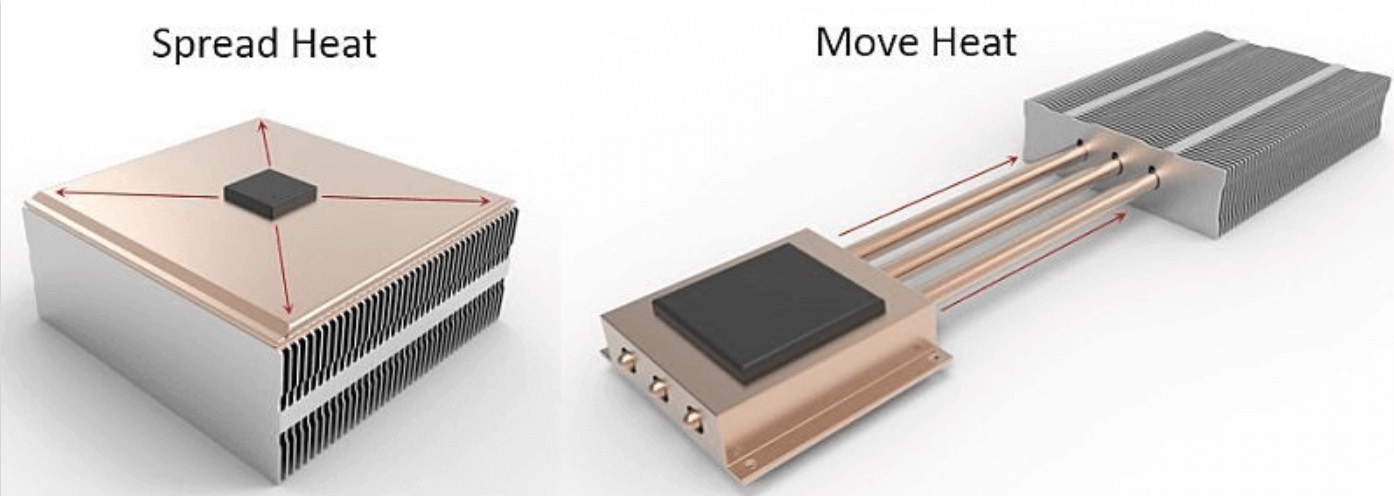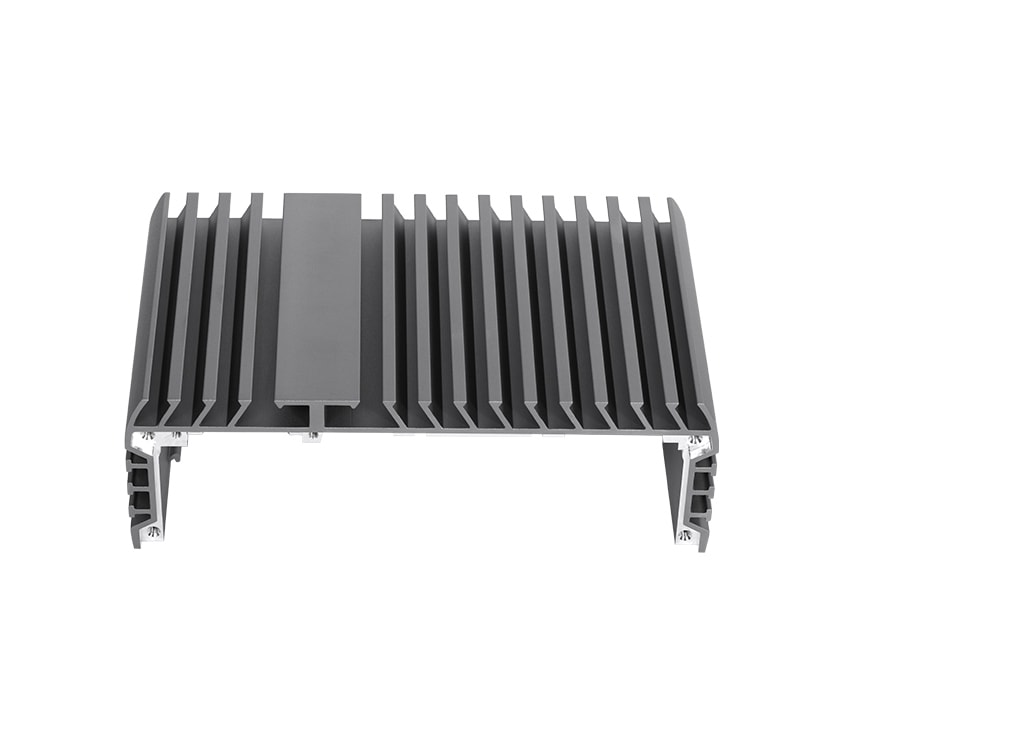Heat pipe is an efficient heat transfer device that uses the evaporation and condensation cycle of liquid to transfer heat, so it is widely used in many demanding thermal management systems. Its basic structure consists of three parts: evaporation zone (heat input end), condensation zone (heat output end) and reflux zone (usually composed of capillary structure). The whole is encapsulated in a sealed pipe, and the inside of the pipe is filled with working fluid. .
In principle, when one end of the heat pipe (evaporation zone) receives heat input, the working fluid in the tube absorbs heat and evaporates into gas, and the generated steam then flows to the other end (condensation zone) with a lower temperature. In the condensation zone, the steam releases heat and condenses into liquid. Through capillary action or gravity, the condensate returns to the evaporation zone to complete the cycle. This cycle utilizes the latent heat of liquid evaporation and condensation, enabling efficient heat transfer.
Heat pipes are more efficient than traditional metal heat conductors because they take advantage of the phase change of the working fluid, a process that can transfer large amounts of heat energy quickly and efficiently. Additionally, a heat pipe is able to operate under nearly isothermal conditions, meaning it can transfer heat from a hotter place to a cooler place with minimal temperature difference.

Heat pipe design and performance are affected by a variety of factors, including the type of working fluid, pipe material, internal structure (such as the design of the capillary structure), and the size and shape of the heat pipe. Depending on application requirements, heat pipes can be customized to fit specific heat loads, temperature ranges, and space constraints, playing key roles in electronic cooling, spacecraft thermal control, and energy systems.
Basic principles and structure of vapor chambers
A vapor chamber, also known as an extended surface heat exchanger or flat heat pipe, is a device used to efficiently distribute and transfer heat, especially in applications that require even heat distribution over a large surface area. Its working principle is similar to that of a heat pipe, but its structure is more suitable for the thermal management needs of flat surfaces or wide areas.
Basic Structure
The structure of a heat spreader typically consists of three main components: a sealed casing, internal working fluid, and an embedded capillary structure or porous medium. The casing is usually made of metal materials with high thermal conductivity, such as aluminum or copper, to ensure good heat transfer performance. The internal space is filled with a small amount of working fluid, such as water, alcohol, or other specialized cooling liquids. These fluids evaporate and condense under the action of heat, thereby transferring heat. The role of the capillary structure or porous medium is to promote the circulation of the working fluid between the evaporation and condensation areas through capillary action.
Working
Principle
When heat is transferred from one or more heat sources to a certain part of the heat spreader, the working fluid in contact with this area absorbs the heat and begins to evaporate. The vapor then moves to a cooler area, releases heat, and condenses into liquid upon reaching the condensation area. The condensed liquid is drawn back to the heat source area through the capillary structure, completing the cycle. This process allows heat to be rapidly and evenly transferred from the heat source to the entire surface of the heat spreader, achieving efficient heat diffusion and cooling effects.
The design of the heat spreader can be customized according to application needs, including adjustments to size, shape, type of working fluid, and filling amount, to meet different thermal management challenges. Its advantage lies in providing a large area of uniform temperature field, making it very suitable for applications requiring large-area cooling and high temperature uniformity, such as electronic devices, LED lighting systems, and solar thermal panels.
Radiator advantages and disadvantages
Advantages
High Thermal Conductivity
:
Heat pipes can rapidly transfer a large amount of heat, significantly outperforming traditional metal heat conduction materials, making them one of the ideal solutions for thermal management.
Nearly Isothermal Heat Transfer
:
Utilizing the phase change process of liquid evaporation and condensation, heat pipes can achieve nearly isothermal heat transfer, ensuring a stable temperature difference between the heat source and heat sink.
Flexible Shapes and Sizes:
Heat pipes can be designed in various shapes and sizes to fit a wide range of complex application environments and spatial constraints.
High Reliability
:
With a simple structure and no moving parts, heat pipes are highly reliable and require low maintenance.
Limitations
Cost Issues:
High-performance heat pipes are costly, especially when special materials or custom designs are needed.
Temperature Range Limitations:
The efficiency of heat pipes is limited by the boiling point of the working fluid, which means their performance could be compromised at extremely high or low temperatures.
Gravity Dependence:
The performance of some types of heat pipes (especially gravity-assisted heat pipes) may depend on their installation orientation, limiting their effectiveness in specific directions.
Manufacturing and Design Complexity:
The design and manufacturing process of heat pipes is relatively complex, requiring precise control over the amount of working fluid, internal pressure, and ensuring good sealing performance.
Despite some drawbacks, the exceptional thermal conductivity and flexible application range of heat pipes make them a crucial tool for solving efficient thermal management challenges. When designing and applying heat pipes, it is necessary to consider both their advantages and limitations to fully leverage their performance.
Advantages and disadvantages of vapor chambers
Heat spreaders, as an innovative solution in modern thermal management technology, have significant advantages but also some limitations.
Advantages
High Thermal Diffusion Efficiency:
Heat spreaders can rapidly and evenly distribute heat, effectively reducing hotspots and maintaining uniform temperature across devices.
Suitable for Large Area Cooling:
Due to their design, heat spreaders are particularly well-suited for applications requiring large-area heat dissipation, such as large electronic devices and solar panels.
Compact Structure:
Compared to traditional heat exchangers, heat spreaders are designed to be more compact and lightweight, making them easy to integrate into various devices.
No External Power Required:
Heat spreaders rely on the natural circulation of the working fluid to transfer heat, eliminating the need for external power sources or pumps, thereby reducing energy consumption.
Limitations
Relatively High Cost:
The design and manufacturing of efficient heat spreaders can be costly, especially when involving special materials or custom sizes.
Limited Temperature Range:
The efficiency of heat spreaders may decrease under extreme temperatures, as their performance depends on the phase change range of the working fluid.
Complex Design:
To achieve optimal thermal transfer performance, heat spreaders require precise design and optimization, which can increase research and development time and costs.
Maintenance Considerations:
Although heat spreaders themselves do not require frequent maintenance, in some applications, such as leakage of the working fluid, professional repair and inspection may be necessary.
In summary, heat spreaders offer unique advantages in providing efficient thermal management solutions, but their application should be weighed against specific needs, costs, and design considerations.
Application Fields Comparison and Introduction to Our Company's Product
Our company specializes in the development and manufacturing of advanced heat spreaders tailored for high-performance electronic devices, renewable energy systems, and industrial machinery. Our products stand out due to their superior heat diffusion efficiency, enabling them to manage the thermal requirements of cutting-edge technologies such as high-speed processors, LED lighting, and photovoltaic panels. The compact design of our heat spreaders allows for seamless integration into a wide range of applications, providing a versatile solution to thermal management challenges.
Moreover, our heat spreaders are designed with a focus on sustainability, requiring no external power to operate and thus contributing to energy efficiency in the systems they are part of. While we acknowledge the higher initial costs associated with our high-quality materials and precision engineering, we believe the long-term benefits, including reduced energy consumption, enhanced device performance, and lower maintenance requirements, offer significant value to our customers.
In response to the limitations of traditional thermal management solutions, our company continuously innovates to improve the temperature range and design flexibility of our heat spreaders, ensuring they meet the evolving needs of our diverse client base. Our dedicated R&D team works closely with clients to customize products that not only meet but exceed their thermal management expectations, offering professional support for any maintenance needs.

